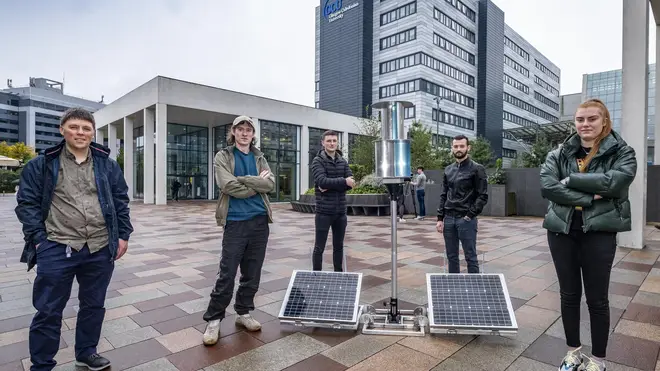
Matt Frei 10am - 12pm
25 November 2022, 00:04

Undergraduate engineers from Glasgow Caledonian University developed Douglas Macartney’s idea into a prototype.
A flatpack wind turbine invented by a 15-year-old Scottish pupil is to be used to help provide power to communities in Kenya.
Douglas Macartney, now 19, designed the turbine for a competition in 2018 and it has since been developed into a viable prototype by several teams of undergraduate engineers from Glasgow Caledonian University (GCU).
Students worked over several years to create the prototype, with their input including the addition of two solar panels.
The device, which can be assembled without any specialist training, is intended to be used to help areas recovering from natural disasters and in rural settlements far from grid connection.
GCU is now working with other partners to bring the turbine to Kenya, where it will help rural communities.
Mr Macartney, now 19, designed the turbine when he was a pupil at The Royal High School in Edinburgh.
He said: “Ikea built a flatpack refugee shelter and I quite liked the simplicity of it. I thought of doing the same thing but with something that would have an energy use in a refugee camp.
“Working with the team at GCU has been great. It has been amazing to see how my idea on paper has been turned into a working prototype.
“I have found it interesting to see how it has evolved over time and the process involved in working on a project like this.
“It has been developed way beyond what I would have thought possible when I was coming up with the design.”
The GCU project is one of 64 sharing in £26 million of funding from the UK Government’s Innovate UK Energy Catalyst programme.
GCU will partner with DeCourcy Alexander, a London-based sustainable innovation consultancy, and E-Safiri Charging Limited, a Kenyan company that focuses on research and innovative solutions to provide access to sustainable energy.

The funding will allow the three partners to link UK academia and small-scale rural industry in Kenya, where it is hoped the turbine will help create sustainable economic growth and education that will transform lives.
Andrew Cowell, a senior lecturer at GCU and principal investigator for the project, said: “The wind turbine was conceived to generate enough electricity to power a light and two USBs sockets in a disaster relief zone or a refugee camp.
“The addition of solar panels was inspired partly by Douglas’s original idea, and partly from feedback from an Innovate UK research bid partner. All our calculations show the concept is viable.
“The technology would be able to improve energy access by making it affordable, reliable and low carbon. Our portable and flatpack system is more feasible for deployment in rural areas and could reduce installation and transportation costs – and energy price in general – compared to a conventional system, as it is stand-alone and off-grid, making it accessible to all.
“The local community will be trained on the assembly and use of the device and, ultimately, there are plans to try to manufacture it in Kenya.”
The project is due to start on March 1 and will run for 12 months, including field trials at suitable locations in Scotland and Kenya.
The project will be entitled Angaza Africa – Angaza being the Swahili word meaning “to give light, illuminate, shine”.